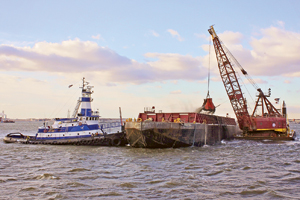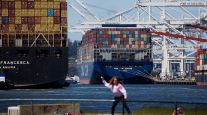Features Coordinator
Dredging Makes Slow, Uneven Progress on East Coast to Welcome Bigger Ships

East Coast ports eager to capitalize on the newly expanded Panama Canal are engaged in massive dredging projects to reach the ideal channel depth of 50 feet or more, but so far results are uneven.
Construction in Panama increased the canal’s productivity to as much as 14,000 20-foot-equivalent units per ship from 5,000 TEUs pre-expansion, according to the Panama Canal Authority website. Interviews with East Coast port officials show those organizations are in different stages of readiness to receive the larger vessels.
INTERACTIVE GRAPHIC: Details on dredging projects.
Several East Coast ports last month logged the first arrival of the larger vessels that now can transit the canal.
“Fifty-foot channels will provide ocean access to accommodate the supersize Panama ships for the demand for international cargo serving the region and the nation,” said Bryce Wisemiller, the New York harbor-deepening project manager with the Army Corps of Engineers.
Ports in Baltimore, Hampton Roads, Virginia, and Miami already have 50-foot channel depth, The Port of New York and New Jersey is targeting completion of a 50-foot-deep dredging project as early as September.
East Coast ports handled more than 20 million TEUs in container traffic during 2015, about a 7% increase over 2014. New York and New Jersey; Savannah, Georgia; and Hampton Roads, respectively, were the three busiest East Coast container ports in 2015, collectively accounting for nearly 12.7 million TEUs, according to American Association of Port Authorities figures.
Those three Eastern ports also are among North America’s seven busiest container ports, although Los Angeles and Long Beach, California, remain the continent’s two largest container facilities.
Dredging to 50 feet in Hampton Roads/Norfolk was completed in 2007, and most of New York and New Jersey hit 50 feet earlier this year. The remaining two contracts in New York will be completed by the end of September, bringing the deepening project to an end, the Corps said in a statement.
Savannah is in the midst of digging its harbor 5 feet deeper than the port’s current 42 feet. Billy Birdwell, a representative for the Corps’ Savannah district said the $134.5 million outer harbor deepening project is running on schedule.
In a July report, the Corps reported that 14% of outer harbor dredging was complete. The outer harbor is scheduled for finishing during the first half 2018. A contract will be awarded for the second phase of dredging in Savannah’s inner harbor once studies are completed and funds are awarded.
Other planned deepening projects include Charleston, South Carolina, Harbor Post 45 and the Norfolk Harbor Channels. Charleston is aiming for a 54-feet channel depth, with other segments dredged to 52 feet.
Norfolk has authorization from Congress to dig out its harbor to 55 feet, but construction may not start until 2018. Arthur Moye of the Corps’ Norfolk district said the port’s goal is to be, “wider, deeper, safer.”
Smaller ports also are engaged in dredging.
Two contracts are starting for North Carolina’s Morehead City Harbor during August. The first two stages for the deepening plan will take channel and harbor depths to 45 feet and more.
The Delaware River Main Channel Deepening Project runs from Philadelphia and Camden, New Jersey, 102.5 miles south through Delaware Bay. The $300 million project is supposed to be complete by the end of 2017 and deepen the channel to 45 feet.
Maintenance dredging is a constant occurrence in many ports and harbors along the East Coast. Baltimore, for example, already has dredged 3 million cubic yards of material from several of its channels this year.


